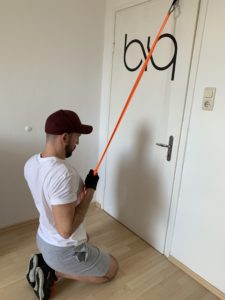Your back contains the most muscle mass in your upper body. But still a lot of people neglect the back when it comes to training and working out. This is a pity, since your back will be a major factor when it comes to having a great fitness or simply looking good.
A hard thing is to get a great back workout if you don’t have access to a gym. The most effective body weight exercises is the pull up, but not many people have a pull up bar at home, and you also need a certain level of fitness to be able to do pull-ups. So how can you work your back without a gym membership? Simple. Resistance Bands!
There is a huge misconception out there that you can’t work your back effectively at home. People who think that never tried resistance bands. With bands, you can easily create enough resistance to stimulate your back for growth and strength.
We gonna start by looking at some information about the anatomy of your back muscles. Straight after we will dive into different exercises you can do for your back with resistance bands.
How To Build Your Back
As already mentioned, the back contains the most muscles in your upper body. I will cover 4 of the biggest and most important when it comes to back training in this section. Latissimus Dorsi, Trapezius, the Rear Delt and the Biceps are the main players in your back if it comes to move load.
Basically all of these muscles will be used in any compound exercise for the back, but with certain exercise choices you can put a slight focus on the traps or the lats.

Latissimus Dorsi – The “outer” back muscles. The lats are large, flat muscles which cover the mid and lower section of your back. The lats are activated more by pulling vertically. In exercises like pull down or pull ups.
Trapezius – The “inner” back muscles. The Traps are a large triangular muscle, which cover the mid section of your upper back. The traps and the rhomboids (not displayed in the picture) are more activated in horizontal movements like rows.
Biceps – The biceps is the upper arm muscle which is responsible for bending your arm. Since most back exercises require a bending of your arms, the biceps is also involved in training the back.
Rear Delts – The rear delt is the back section of your shoulder muscles. It is like the biceps a muscle which is involved in most back exercises.
Important Tips For Back Exercises With Resistance Bands
Here are some general tips that you should always keep in mind when training your back:
Horizontal And Vertical Pulling! For a great back you need to make sure that you’re doing both horizontal and vertical pulling. Like we’ve seen above the back consist out of quite a lot of muscles. Each muscle has its own functionality. Having horizontal and vertical pulling movements in your training guarantees a balanced development of the back.
Full Range Of Motion! Always perform the exercises with full range of motion. You will literally leave results and progress on the table if you stop beforehand and make it easier on yourself. If it is not possible for you to reach full range of motion with a given band, grab a lighter one!
Don’t Swing! Make sure to keep your body stationary during your back exercises. A little swinging is ok to get the last reps done, but don’t make the mistake of getting the thickest band and having bad form throughout the movement. Leave the ego at the door and grab a lighter band.
Time Under Tension! Don’t just do your reps as fast as you can, you need to put your muscles under tension long enough to gain. Squeeze in the contracted portion of the movement and hold for a second, when slowly return instead of “letting go” quickly. This will add more gains to every workout.
No Slack! In your starting position you need to have already some resistance in the band. Check consciously that you feel the band pulling on your arms before you start the exercises.
Now we are done with the compressed portion of theory. Let’s jump into the different back exercises and get you some inspiration for your next workout.
The Best Back Exercises To Do With Resistance Bands
I have collected here all the exercises from compound to isolation exercises, the order is not a ranking from “best to worst”. But make sure to implement vertical and horizontal pulling movements in your back workout!
Compound Exercise #1 – Rows (Horizontal Pulling)
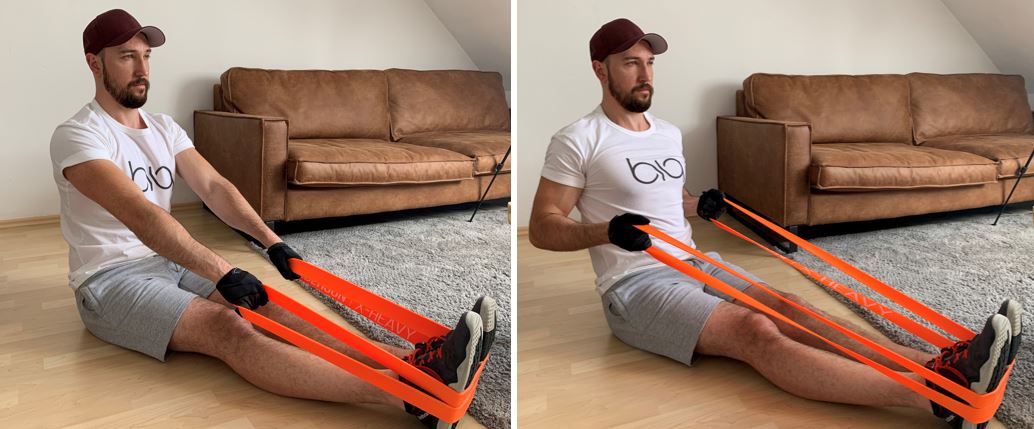
My most favorite row variation is the sitting version. I find it the most comfortable one, and I don’t have to lose any thought on keeping my stability.
- Double up the band (grab one which actually lets you do it in a full range of motion)
- Grab each end with one hand inside the loop
- Place the band securely around your feet (shoes are recommended)
- Keep your legs straight and brace your core
- Pull towards your belly button until your elbows pass your upper body
- Return slowly to the starting position by controlling the band
There is so much more to be said about the perfect row. Especially what difference special grips and elbow position will make while doing the exercise. I have a full article about the Seated Row where you can find more tips to do this exercise here.
Variations
The seated version of the rows is not the only one. Rows are very versatile and I prepared two variations which are great as well and definitely worth a try!
Bent Over Rows
For some in depth information on this variation check out the full article right here.

Standing Rows
Find out how to do this variation with all its tweaks and special tips in the full article right here.
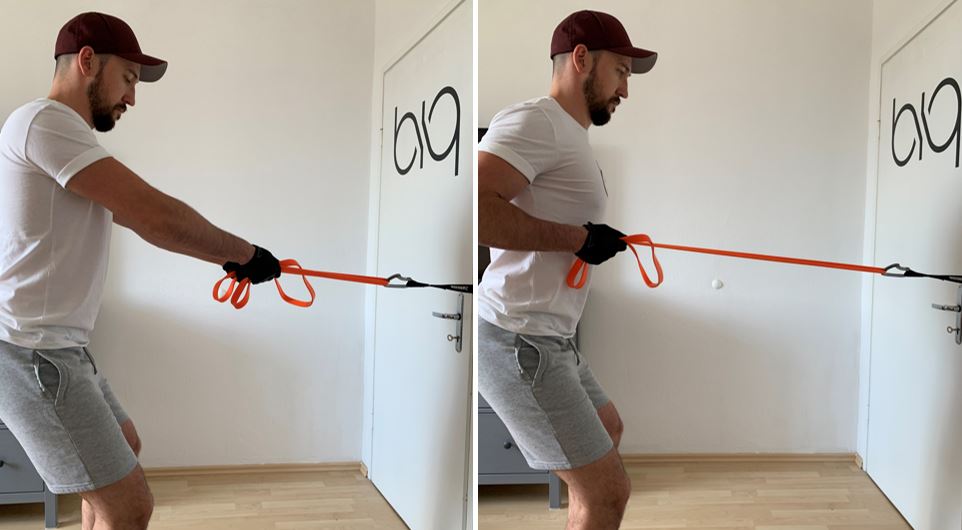
You can find more details on the different variations for the chest press here.
Compound Exercise #2 – Pull Downs (Vertical Pulling)
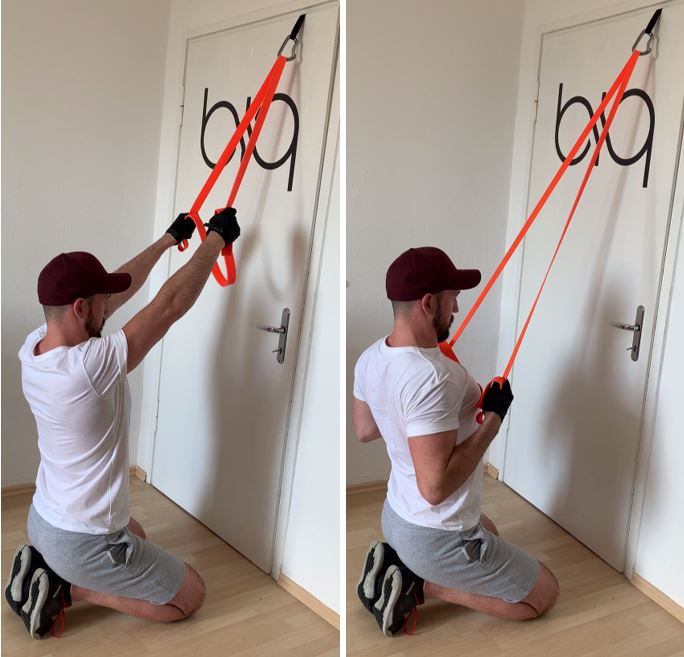
The basis for your vertical pulling, the Lat Pull Down. Your Lats will be working especially hard in this exercise.
- Attach the band to the top of the door with a door anchor or anything else, the higher the better
- Get on your knees holding the resistance band in front of you
- Grab the band at a level that makes sure you’re having already some stretch in the starting position
- Brace your core
- Now bring your hands down towards your chest
- Hold for a second and return to the starting position
Make sure to check out the full article on the Lat Pull Down right here. There you can read about important Does and Don’ts as well as find a more detailed description of how to perform this movement. Also, you will find different grips and elbow position and what effect they will have on this movement.
Variations
Some variations for the regular pull down is the lying down version as well as the variation with one side at a time.
You can find more details on the different variations for the Lat Pull down here.
Compound Exercise #3 – Pull Ups (Vertical Pulling)
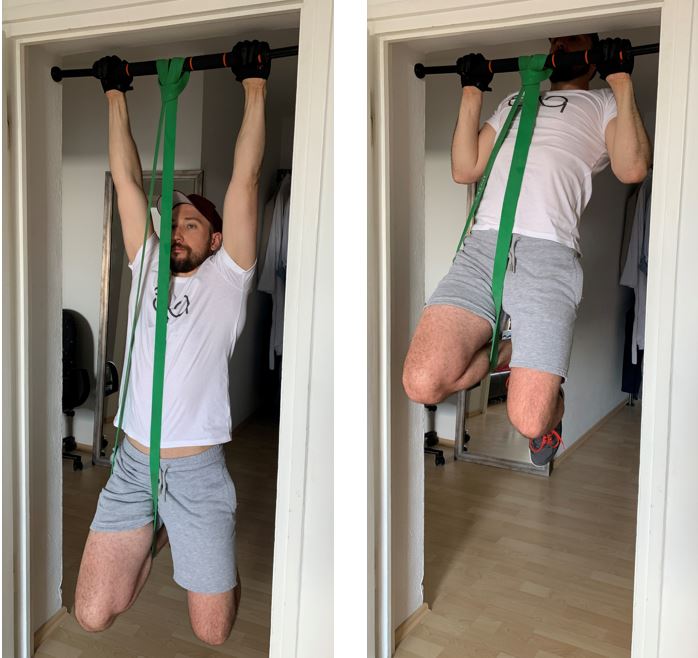
The king of bodyweigh exercises – the Pull Up. If you’re looking for only one exercise to do the rest of your life for your back, this is the one. Resistance bands are a great tool to get you started with Pull ups. Especially to get yourself to the first pull up can be quite a hard task. If you incorporate resistance bands you can start banging out pull ups from your first rep on!
- Find yourself a bar which supports your bodyweight
- Wrap a band around the bar and form a loop
- Pull the band down and place it slightly below your knee or under your foot
(The knee version is safer against you losing the band and for it to snap back towards the bar) - Grab the bar around shoulder width
- Now squeeze your shoulder blades together and down and pull yourself up until your head passes the bar (if possible bring your chin over the bar)
- Lower yourself back down until your arms are straight again (do it slowly)
- Repeat steps 5 and 6 for reps
Isolation Exercise #1 – Pull Over
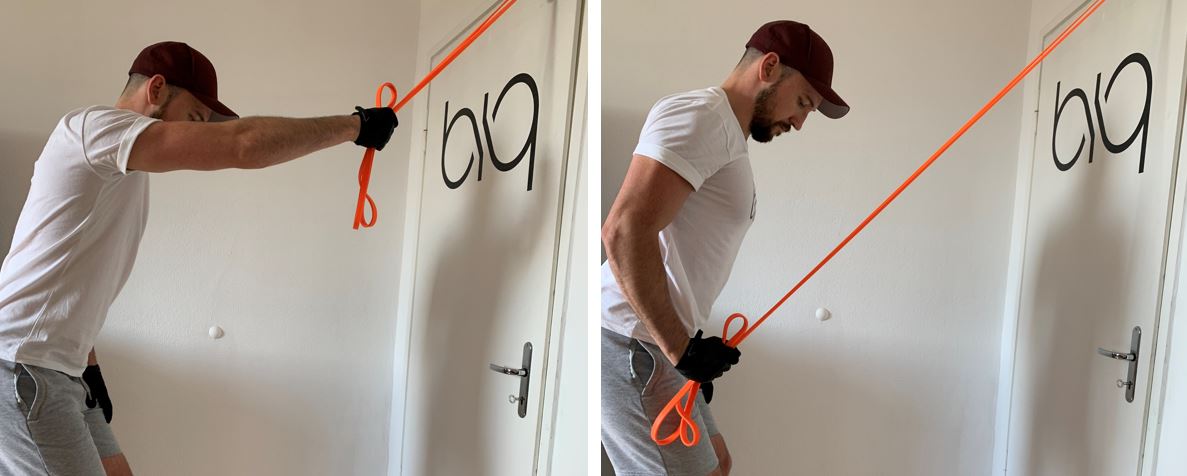
The Pull over is quite an all-rounder. It targets the lats very intensively but also the chest muscles as well.
- Attach the band to the anchor point on a level above your head.
- Grab each string of the band with one hand (I like to wrap it around my hands to prevent slipping of the band) – Or do it for one side at a time
- Take a step back so you have no slack in the band in the top position.
- Now place your feet shoulder wide apart and brace your core.
- From here bring your hands towards your hip while having almost straight arms.
- Return to the starting position and repeat.
Find more tips to do this exercise in perfect form here.
Isolation Exercise #2 – Pull Apart / Reverse Fly

The perfect isolation exercise for your rear delts and the rhomboids. The pull apart is great for warming up or as finisher exercise at the end of your workout.
- Get into an upright position with a neutral spine
- Hold the band in front of your body at the height of your chest
- Now you will pull the band apart by squeezing your shoulder blades together as you pull back
- Hold this position for a second and when return VERY slowly to the starting position
Find more tips to do this exercise in perfect form here.
The Reverse fly is a very similar exercise which I won’t show here in detail, but make sure to check it out in the full article right here.
Isolation Exercise #3 – Shrugs
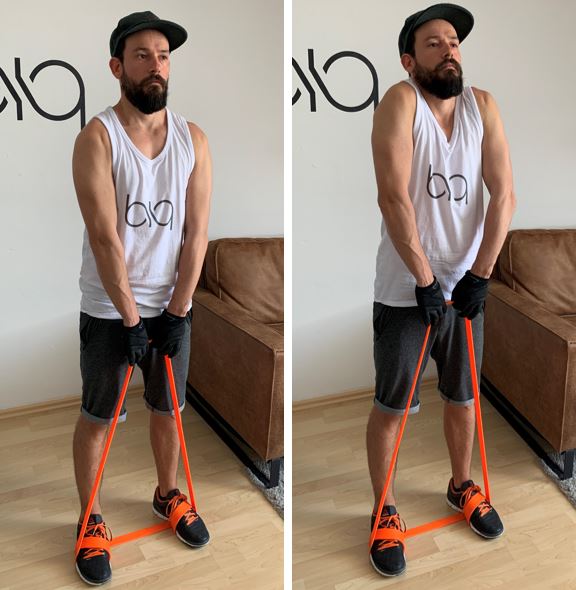
The best exercise to target your upper traps are the shrugs, period.
- Step on the band with both feet and grab the band with both hands
- Hold your hands close to your body
- Now bring your shoulders straight up (without bending your arms or moving your head down)
- Squeeze your upper traps really nice and hold for a second before returning to the starting position
Find more tips to do the shrugs in perfect form as well was variations for the shrugs in the full article right here.


